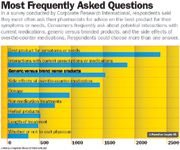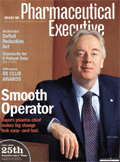Marketing to Professionals: Penetrate the Point of Purchase
Noncompliance causes 125,000 deaths and more than $100 billion in increased healthcare expenses.
What is the most dangerous drug on the market? For many patients, it's the drug they take incorrectly or fail to take at all. Patient persistence and compliance, though they rarely make it to the front pages of newspapers, are an immense public health problem, as well as an ongoing business problem for pharma. Companies have recently been exploring ways to enhance compliance, working through doctors, Web sites, and other direct-to-patient communications. But they often neglect one key tool for compliance: the pharmacist. New research, involving both surveys of pharmacists and "mystery shoppers," shows what's happening and not happening at the drugstore counter, and suggests some ways companies can make use of a neglected resource.

Mike Mallett
Counter Intelligence
Clinical studies suggest that, in general, only half of all patients who are instructed to take a prescription drug still take it one year later, and as many as one-third of all prescriptions are never refilled.
The cost of this sort of noncompliance is staggering. Studies estimate that noncompliance causes 125,000 deaths and more than $100 billion in increased healthcare expenses and productivity losses. Beyond that, pharmaceutical manufacturers lose about $15 billion to $20 billion annually in future sales from brand switching and negative word-of-mouth caused by perceived product failure—which happened because the patient didn't take the medication as directed.
The reasons are as varied and personal as the individual. For some, the cost of the medication is prohibitive. Patients split pills, take them irregularly, or just don't refill the prescription. For others, the unpleasant side effects aren't worth the benefits. Or, patients may not perceive any benefits for symptomless conditions such as high cholesterol or high blood pressure.

But alongside those personal reasons, there is a breakdown at the pharmacy counter. According to a survey we conducted of 5,952 panelists, only 21 percent of pharmacists discussed with respondents potential side effects when they filled a new prescription. The survey also showed only one-third of pharmacists stressed the importance to patients of taking the prescription as directed, for the full duration, or whether or not they felt better or experienced side effects.
Meanwhile, less than 20 percent of those surveyed said someone from the pharmacy contacted them after the prescription was filled, and about the same number of respondents said their pharmacy notifies them when a prescription needs to be refilled.
Mystery Data
One important tool for exploring the interactions that take place at the point of purchase is the use of mystery shoppers—trained auditors who anonymously evaluate customer service, operations, employee integrity, merchandising, product quality, and other factors. For many years, the retail and restaurant industries have employed mystery shoppers to collect unbiased, third-party information about their stores and their sales associates. Pharma companies can apply the same strategies to better understand patient–pharmacist relationships that may influence compliance.

Most Frequently Asked Questions
The opportunities are abundant. More than 130,000 retail pharmacists work in 55,200 retail pharmacies nationwide. Mystery-shopping programs can provide insight and data to pharma companies on a wide range of possibilities for noncompliance, including pharmacist conversations and recommendations on particular medications. Ultimately, the information can uncover potential areas for pharma companies to direct their outreach and educational efforts.
In spring 2006, Corporate Research International sent 520 trained undercover auditors, all with diabetes, into pharmacies nationwide to collect information on pharmacist recommendations for glucometers and other diabetic needs.
When asked to recommend a glucometer, six percent of the pharmacists preferred the generic brand; the balance was split about equally between Accu-Check, One Touch, and other miscellaneous products. Ease-of-use was the number-one reason pharmacists suggested one brand over another.
The results suggest a strategy for improving market share: educating pharmacists to help them better understand what sets a brand apart. And because ease-of-use is a key concern, there is a good chance that marketers for a particular brand can improve its position by teaching pharmacists how to use the glucometer—and how to teach patients to use it.
For glucometers, the key issue is driving share. But it is clear that companies can drive compliance by using similar strategies with pharmacists, especially for drugs that involve delivery systems such as inhalables or injectables.
Pharmacists as Marketers
Mystery shopping also is an effective tool for evaluating how pharmacists position a particular brand. In fact, just as retail outlets depend on sales associates to deliver on the stores' brand promise, pharmacists can either make or break consumers' perception of a brand. By consistently evaluating how pharmacists represent a brand, pharma companies can implement necessary training programs to build pharmacist—and, therefore, patient—trust of the medication.
An example: Mystery shoppers have reported that some pharmacy personnel respond to complaints about the price of medications by agreeing—or even by criticizing the manufacturer. To combat behavior like this, companies must ramp up educational efforts not only about the value of the medication, but also about company access programs available to those in need. With this information, the pharmacist—acting as a brand representative—can build good will and possibly help remove one barrier—cost—to improving patient compliance.
At one time, identifying specific patients for additional one-on-one counsel would have been cumbersome. However, new tools are opening untapped avenues for efficient and effective pharma–pharmacist partnerships focused on persistence and compliance.
For example, Web-based, HIPAA-compliant, secure communication tools are becoming more integrated into pharmacists' workday. These electronic means provide one way for pharmaceutical companies and pharmacists to enhance compliance.
Say a specific medication has particularly severe side effects. The pharma company can work with the pharmacist, using Web-based tools or computer software, to automatically flag every new patient filling a prescription for this particular drug. The pharmacists can then implement a call program to encourage patients to continue correct administration, despite the side effects. The same HIPAA-compliant process can work for refills or a multitude of other scenarios to leverage the trust between pharmacists and patients in a way that's beneficial for all parties. A variety of pharmacological studies have found that when pharmacists work with patients in their community, adherence to medication regimens improve.
Health-risk assessments, whether conducted jointly with the pharmacy or sponsored by the pharma company, present another chance for pharmacists to reinforce the importance of consistently taking preventive medications.
Pharmacy-based clinics also offer additional opportunities to leverage the patient–pharmacist relationship. In some cases, the clinics are seasonal, with pharmacists providing flu or pneumonia vaccinations. Other clinics range from asthma screenings to basic primary care services. And many pharmacists are now offering medication therapy management (MTM) to qualifying patients who are enrolled in Medicare Part D. All of these venues facilitate conversations between pharmacists and their patients, providing repeated occasions to reinforce the compliance message.
Enhancing the Conversation
Patients get the most benefit from medications that are taken as directed. Patient compliance increases store traffic and prescription revenue for pharmacies, especially for maintenance and long-term prescription therapies, and it also increases sales for the pharmaceutical companies.
Of course, responsibility to take medications ultimately rests on the patient. But because of the level of respect and trust pharmacists have earned, their interactions and counsel can have a positive effect on an individual's compliance. Savvy pharma marketers will look for opportunities to further enhance the patient–pharmacist conversation.
Mike Mallett is CEO of Corporate Research International. He can be reached at mmallett@corpri.co

The Misinformation Maze: Navigating Public Health in the Digital Age
March 11th 2025Jennifer Butler, chief commercial officer of Pleio, discusses misinformation's threat to public health, where patients are turning for trustworthy health information, the industry's pivot to peer-to-patient strategies to educate patients, and more.
Navigating Distrust: Pharma in the Age of Social Media
February 18th 2025Ian Baer, Founder and CEO of Sooth, discusses how the growing distrust in social media will impact industry marketing strategies and the relationships between pharmaceutical companies and the patients they aim to serve. He also explains dark social, how to combat misinformation, closing the trust gap, and more.